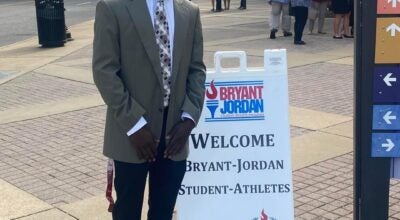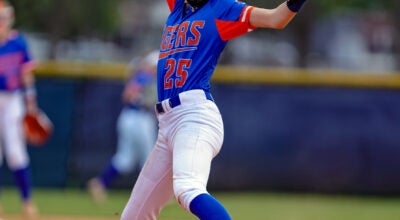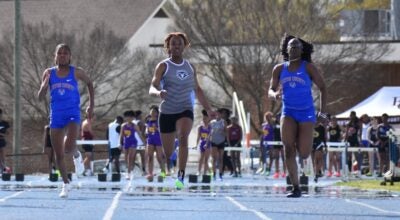Fay gives gator hunters fits
Published 6:36 pm Monday, September 1, 2008
Tropical Storm Fay took a big bite out of Alabama’s 2008 alligator hunting seasons. The slow-moving tropical storm basically caused a washout out of the season at Lake Eufaula and severely limited the hunting in the Mobile-Tensaw Delta region.
Bill Gray, wildlife biologist in charge of the Eufaula hunt, said only three of the 40 permits were filled with the largest at a little more than 7 feet long. More than six inches of rain fell during the three-night Eufaula hunt.
On the other hand, the Delta region hunts spanned two weekends and hunters managed to have decent weather for three of the six nights of hunting, although the success rate fell short of the previous two seasons. Of the 125 permits issued, a total of 78 gators were checked in at the Spanish Fort Wildlife and Freshwater Fisheries Division office.
“Overall, it was pretty good,” said Chuck Sharp, wildlife biologist in charge of the Delta region hunts. “It was obviously marred by weather conditions. There was a rainout on the first Friday night from a local weather system. Then the whole second weekend was impacted by Tropical Storm Fay. They were able to do a good bit of hunting on Friday night, but then there were small craft advisories on Saturday and Sunday. We were still here, but nobody brought in a gator, and it was a wise decision not to try it in those conditions.”
The impending storm caused hunters to take the first decent gator they saw on the second Friday night, which increased the number of female gators harvested.
“There were significantly more females taken than last year, which is good in terms of keeping the population in check,” Sharp said. “They were more willing to take one of the first animals they saw and not wait for one of the biggest. We still took a lot more males than females. There’s no way to tell before taking them, and hunters are usually trying to take the biggest gator they can and most of the time that’s going to be males. But there are still a lot of gators – we’re just basically taking off the surplus.”
The alligator season started in Alabama three years ago with 50 permits in the Mobile-Tensaw Delta. The second year, the permits in the Delta increased to 100 and 40 were issued for Lake Eufaula. The number of permits was increased to 125 in the Delta this year, in part because of an expansion of the hunting area.
“We doubled the size of the hunting area,” Sharp said. “There are a lot of animals in the upper Delta and all the way to the Clarke-Monroe County line. And there were a good number of gators taken from those lakes up there.”
Sharp said if the weather had been decent the harvest numbers would have probably exceeded 100 animals, which would be in line with the success percentages from the first two years.
“A lot of people had passed animals on the first weekend, looking for a bigger one,” he said. “They thought they would have another chance. Even though we lost most of the second weekend, we still had some big gators brought in.”
There were five gators heavier than 500 pounds and nine more between 450 and 500 pounds. Emory Raulerson of Elberta took the heavyweight prize with a 540-pound gator that measured 12 feet, 5 inches. Brent Gillen of Foley took a 12-4, 535-pounder, while David Jemison of Saraland weighed in a 12-5, 520-pounder. James Glasgow of Aliceville had a 514-pounder that measured 12-3, and Rodney Smith of Saraland took a 12-3, 507-pounder.
Raulerson – who hunted with his brother, Kevin, and cousin, Eddie Jones – said pre-hunt scouting allowed them to locate his big gator.
“We actually spotted him a few nights before while we were scouting,” Raulerson said. “We saw him on Friday night and decided to wait until Saturday night to go after him. We finally got on him about 4 a.m. Sunday. It was almost too late because hunting ended at 6 a.m., but we decided to try it.
“We got a hook in him and probably 20 minutes later got another hook in him. Their skin is so tough that unless you hook him under a leg or under the jaw you won’t penetrate the skin. We got lucky and hooked him in the webbing of his foot.”
Last year, Raulerson was a hunting assistant for his brother, Eric, and they bagged a 446-pounder. They used a rope to tie the gator’s tail last year but decided to go with a snare during this year’s hunt.
“All the hooks held until we put the snare on him,” Emory said. “Once we put the snare on him, he went crazy. The whole world broke loose. He saved it all for the end. He had pulled in some shallow water, about 2-2 ∏ (one-half) feet deep. It’s hard to fight a gator in shallow water. He got under the boat and had the leverage on us. He threw the bow at least 3 feet out of the water. He bounced the boat up and down, like beating it with a sledge hammer.
“He knocked us off our feet, and I grabbed my cousin to keep him from falling out of the boat. He would have fallen right on top of the gator. He banged us up good. I thought he was doing damage to the boat. I’d have been nervous in another boat, especially in my old Stauter. It would have been in pieces.”
Fortunately for Raulerson and his crew, the gator ended up turning around and pulling the boat back into the middle of the river. They followed the gator until 5:45, when they were able to dispatch the gator.
The next chore was getting the big gator in the 18-foot Stratos fish-n-ski boat.
“He was just dead weight,” Emory said. “We had to get the boat moving and get the gator on top. You don’t realize how heavy 540 pounds is until you start trying to load one. We finally got him across the back of the boat. But we never could get the boat to plane off with that gator on the back. We had to chug back in and got to the weigh station at 6:45.
“It was a lot of work, but it was all enjoyable.”






